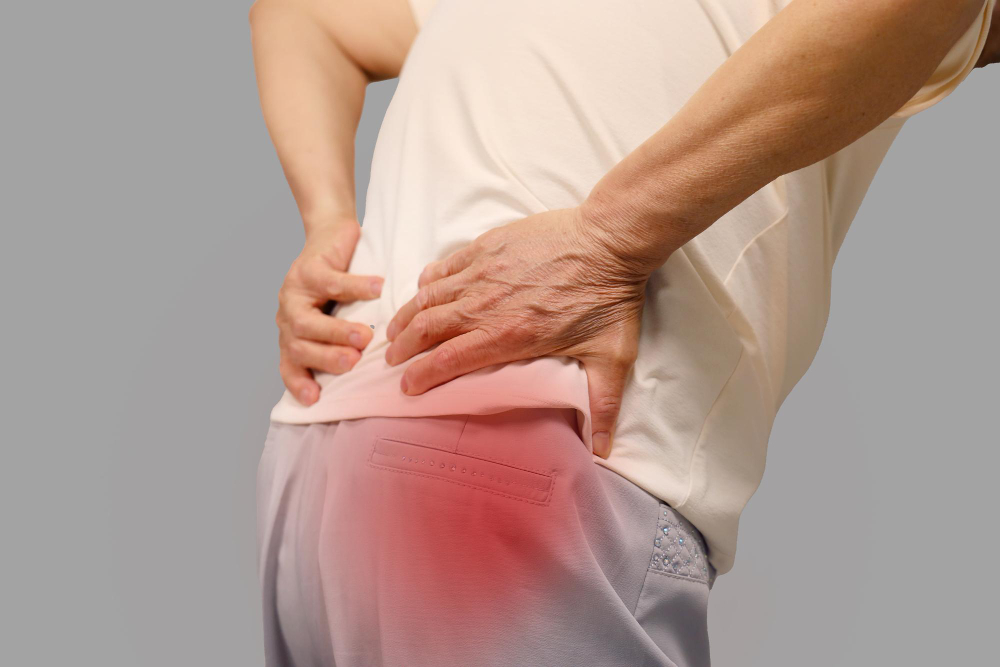Sciatica is a condition marked by pain that radiates along the path of the sciatic nerve, the longest nerve in your body. This nerve starts in the lower back and runs down the back of each leg and when something compresses or irritates the nerve (like a herniated disc, bone spur or spinal stenosis) it can lead to a sharp, sometimes burning pain that travels from your lower back and shoots down one side of your body. In some cases, it’s not just pain as there can also be tingling sensation, numbness or muscle weakness in the affected leg or foot.
For many, it feels like a constant deep ache that worsens after sitting or standing too long. Others describe it as a sudden electric jolt, and the discomfort might be mild one day and unbearable the next. What’s particularly frustrating is how much it can interfere with everyday life where walking, working or even just relaxing can become a challenge.
Common Signs You May Be Dealing With Sciatica
The pain is usually localized to one side of the body and often begins in the lower back, radiating through the buttock and down the leg. It can even reach the foot in some cases, although unlike general back pain, sciatica is more about nerve pain. It may be sharp and sudden or persist as a constant dull ache. Sitting for long stretches or standing up too quickly often makes it worse.
Many people also report a sensation of pins and needles, or a burning feeling running down the leg. In more severe cases, sciatica may cause muscle weakness or even a loss of control in the leg. This is especially concerning when it starts affecting balance and mobility. While some might try to simply “walk it off” or adjust their posture temporarily, these fixes rarely address the root of the problem.
The Role of Foot Alignment in Sciatica Pain
It might seem odd to think your feet could have anything to do with back pain, but the connection is more important than most realize. Your body moves as one connected system. When the feet are not aligned properly (possibly due to flat arches, overpronation or uneven gait) it sends a ripple effect up through the ankles, knees, hips and into the spine. This imbalance places additional strain on the lower back and can aggravate the sciatic nerve.
Every step you take can either help or harm. Poor mechanics mean your body is constantly compensating, shifting weight unevenly and straining muscles that are already under pressure. Over time, this misalignment adds up and what begins as minor discomfort in the back or hips can develop into full blown nerve pain that radiates down the leg.
Correcting these mechanics at the foundation (which is your feet) can offer long term relief, especially when combined with other sciatica management strategies.
How Custom Insoles Can Help Ease Sciatica
Custom insoles offer targeted support by aligning the foot in a way that promotes better posture and more even weight distribution. This doesn’t just help your feet as it also reduces stress on your knees, hips and spine. By encouraging your body to move more naturally, custom insoles take pressure off the areas that aggravate the sciatic nerve.
Unlike off the shelf inserts, custom made insoles are based on your individual foot shape and gait pattern. This precision allows them to address the specific structural issues that may be contributing to your back pain. When your feet are properly supported, it’s easier to maintain a neutral spine and reduce the kind of overcompensation that leads to nerve compression.
The result is that you may notice less pain throughout the day, improved mobility and a greater ability to stay active without flaring up your symptoms. Over time, these benefits can also support long term recovery and reduce your risk of future flare ups.
Why Taking Action Early Matters
Ignoring early signs of sciatica often leads to prolonged pain and reduced quality of life. The longer the nerve is compressed or irritated, the more difficult it can be to recover fully. While painkillers and temporary fixes might offer short term relief, they don’t address the underlying issues that continue to fuel discomfort. Simple lifestyle changes like improved footwear, daily stretching or core strengthening can help, but combining these with custom foot support can make a significant difference.
We understand how frustrating it is to deal with chronic nerve pain, and that’s why our custom insoles are designed to help you get back on your feet. Let proper support guide your path to relief.


